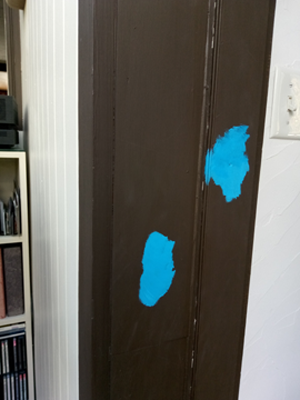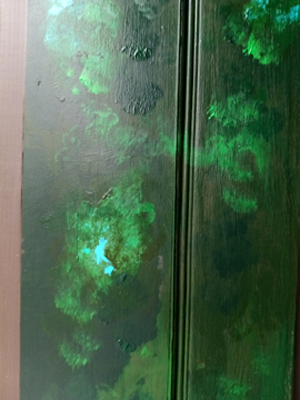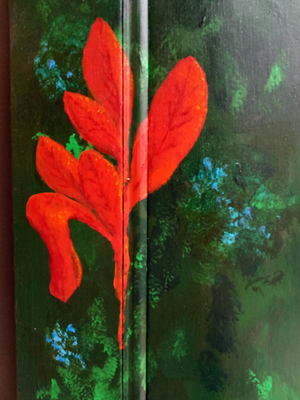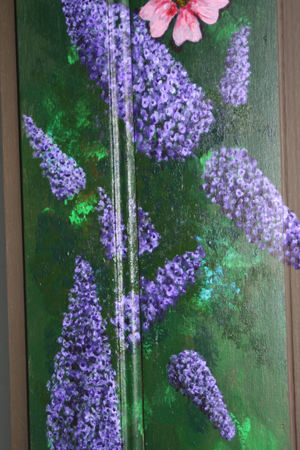Keeping in Touch with the Garden
Dear Reader,
For someone who painted close to 300 tree stumps (Judy’s
Journal, 2009 and 2017 June), a million-year-old rock (2021
November), a dead fig tree (2011 July) and a dead redbud (2021
July), a door frame seemed like fair game.
This time, inspiration took a front seat when summer made its
usual turn toward autumn. Flowers faded, stems grew gangly,
and there would not one blooming anything to look forward to
until late March or early April. I realized that winter was
poised with her offerings: slanted beams of light roaming over
the snow, glittering ice on bare-branched dogwoods, a cardinal’s
flight toward his mate, who waits in the apple tree. It was
September, and I stood in front of the hibiscus, heavy with
its impossible array of red blossoms, asking myself, “How
can I capture some of the garden’s joy to winterize my
soon-to-be flagging spirits?” I’m talking to you,
fellow SAD sufferers.
A glass room at the back of the house is surrounded by John’s
garden. Entry is from a doorway in the back hall. Weeks went
by after I came up with the idea to paint the inside door frame
with flowers. I had no idea how to begin and was uncharacteristically
timid and reluctant. Why should I be? I could paint over the
door frame if I failed. I began to think about the elements
of a garden: light. I would begin with some sky peeking through.

Next came the greens representing leaves. The fun began as
I mixed and dabbed greens, creating areas of color on the sides
and overhead, with the sky peeking through here and there.

I was getting used to the physical act of painting the inside
of a door frame. After a few hours, I realized that it required
a level of stretching and contortion different from standing
in front of an easel or sitting at a drawing table. My back
was complaining. But I had begun. During the next several days,
I took regular breaks to avoid back pain. The garden came to
life! Hydrangeas floated. Daisies danced. Cosmos nodded. The
music played, and I was happy.

Enter the phase of “Am I finished yet?”
When I felt satisfied with the result, I stopped. However,
living with your work, coming upon it unexpectedly –
giving days over to examining passages that pleased and ones
that did not – all help to answer the question. It started
with the canna lily.

Fortunately, cannas bloom until the first frost,
so I could go nose to nose with my subject in the garden.
For me, it’s all about the delicacy of their nearly translucent
petals that ignites their red-orange color. I looked at my
door frame likeness: too much volume, no glow, too sculpted,
ponderously heavy. Farewell, canna lily. Hello, green background.
What other flower could occupy the space? I decided to give
lilacs a try. Ours were long gone, so I looked on the Internet
for images to jog my memory. As I painted, not just one lilac,
but a surreal circus of purple blooms tumbled down the door
frame. I laughed out loud. And don’t tell me they look
like delphiniums! I say, “Maybe they are!”

Among the many lessons learned from this project
was an appreciation for how much time I spend at the kitchen
sink, which has a glassless window above it. This is what
I see. Winter is coming.

